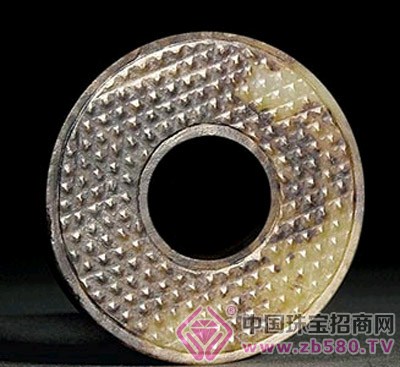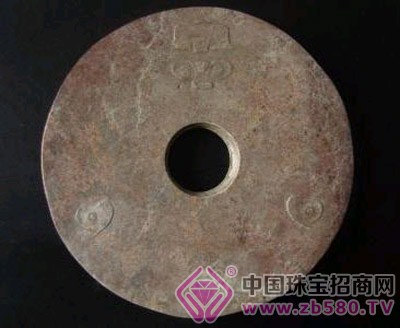The jade is a flat circular jade with a perforation in the center. It is one of the traditional jade rituals in China and one of the “six ruinsâ€. "Erya releaser" contains: "The meat (around the side) is better (the middle hole) is called the ç’§, the good meat is called the ç‘—, the meat is as good as the ring." According to the size of the central aperture The flaky round jade is divided into three types: jade, jade and jade. From the archaeological excavations, when the ancients made jade articles, there was no strict regulation on the ratio of the aperture to the body of the jade. Therefore, today we are accustomed to refer to the round-shaped small-aperture rounds as the ç’§, and the narrow sides. The large aperture is called the ring, and the name "ç‘—" is generally no longer used. Yuxi is an early and continuous variety in Chinese jade. It is very important Ruiyu. The Warring States to the Han Dynasty is the heyday of the jade. The jade is extremely fine, the production process is extremely fine, and the pattern is changeable. The variety of decorative patterns is extremely rich, and the range of use is greatly increased, and the number is also the crown of the past. Jade characteristics The Neolithic jade is limited by the cutting tool, the shape is not regular, or the outer circumference is not round, or the thickness is uneven, the wall surface is not flat, or the cutting marks are left, or the width of the two sides is inconsistent, or the perforation is biased, and the hole side has Slope. The edge of Hongshan culture jade meat is thin-bladed, the natural cockroach is lighter, the ochre is less, only reddish brown, rust and grayish black; the outer edge of Liangzhu culture jade is thin, the inner edge is thick, æ²The color is mostly foggy grayish white. The jade in this period is generally jade, green jade, gray jade, and pale topaz. Most of the features are plain and no grain, and the polishing is brighter. The Shang and Zhou Dynasties were the development period of the jade, and they were special rituals for the nobles. The size of the jade in this period is smaller than that of the Neolithic Age. They are all round, the wall is smooth, the inner and outer edges are of equal thickness, the outer edge is rounded, and the holes facing the two sides are generally regular. The Shang Dynasty has more than no grain on the surface of the jade; the western wall has no lines, and the small wall has beautifully carved patterns. The main theme is dragon, phoenix and bird. Commonly used a combination of a wide Yinxian and a fine Yinxian to engrave the wall pattern, the wide Yinxian is dug into a slope shape, the pattern has more arcs, the lines are natural and smooth, and the dynamic shape is soft and beautiful. The jade materials used are mostly Xinjiang Qinghai, Bi, White jade and Nanyang jade, Xiuyan jade. In the Spring and Autumn Period and the Warring States Period, the jade began to be used for a large number of jade ornaments and funeral jade, as well as a token of ceremonial occasions. Most use Xinjiang Qinghai, Bai, Jasper. The diameter of the worn wall is generally within 10 cm. The diameter of the wall that is not used for burial or as a ritual is between 15 and 25 cm. The wall of spring and autumn is thin and the thickness is about 1 cm. The surface of the Warring States Wall is divided into one, two or three zones of concentric circles, the inner and outer zones are twisted into a double dragon, and the middle zone retains the traditional grain. The inner and outer edges are carved with a negative line, and the cross section is triangular and ribbed. During this period, there were innovative productions such as the appearance of jade, that is, the image of animals that were born on the inner or outer edge. The engraving technique generally uses the combination of thick and thin Yin lines, with fewer thick lines, more thin lines, and lines with burrs. The knife is sharp and straight, the knife marks are deep, and the corners are sharp. The grainy mastoid is full and well-proportioned, and the grain pattern is formed by adding a negative line on the breast line. The Han Dynasty has followed the style of the Warring States and changed slightly. The jade is still dominated by white, green and jasper, but the shape of the wall is increased, and some diameters are 30 to 50 cm or more. There are more dragons, phoenixes and birds in openwork. The grain on the wall, the pebbles are large and sparse, shallow and convex, and the upper part of the grain is round. The edge of the jade is widened and the cross section of the rim is square, which is distinct from the triangular rim at the time of the Warring States Period. At the same time, the combination of patterns is more popular, and some are decorated with auspicious characters. In the Eastern Han Dynasty, the wall was thickened, and the outer façade was slightly curved, but the number was gradually reduced. The rise of antique jade in the Song Dynasty, along with the imitation of the Warring States and the Han Dynasty. The jade has a rounded corner, and there is no sharp edge. The valley nail is densely blurred, the grain rotation is not strong enough, and the valley tail is rounded and ridged, which is different from the fine grain line of the Warring States valley. The jade plaque engraved with dragon's plaque, the long scorpion bifurcation, the inner end of the fork, has the characteristics of the dragon plaque in the Song Dynasty. In the Yuan Dynasty, the Yuxi was more imitation of the Tang Dynasty, with a small size and a large number of small walls, mainly for wearing. Most of them are only carved on one side, the wall is thick, the grain is sparse, and the arrangement is irregular. The animal is carved on the wall, and the animal has the style characteristics of the Yuan Dynasty craft. In the Yuan Dynasty, the jade carving knife was rough, and the knife was deep. The blade often had a profile phenomenon, and the carvings were not lacking in exquisite work. The number of jade in the Ming Dynasty was higher than that of the previous three generations. More choices of green and white jade, but also a small amount of jasper. Most of the body is relatively small, common embossed crepe, but also a lot of grain and moiré. The nipple particles are round and large, slightly flat, and often have traces of tubular drills. The Ming Dynasty jade is mainly used for wearing. Engraving is more casual and rough. In the Qing Dynasty, the jade was much smaller, the wall was thicker, the perforation was smaller, and the double wall with the ring sleeve appeared in the middle. The pattern on the jade has a geometric pattern, auspicious patterns and character patterns, which are more realistic. During this period, regardless of the court, the official, and the private sector, the wall was popular. At the time of Qianlong, the antique jade was realistic and very beautiful. In the late Qing Dynasty, the quality of the jade was poor, the work was rough, and there was no rule in the carving, only the shape was similar, and the workmanship was not sought, and the process water was greatly reduced. Sport Tye-Die Sock,Cotton Sport Crew Socks,Tye-Die Knit Crew Socks,Popular Tye-Die Socks Jingjiang Pingdong Import&Export Co.,Ltd , https://www.jjpdsocks.com
